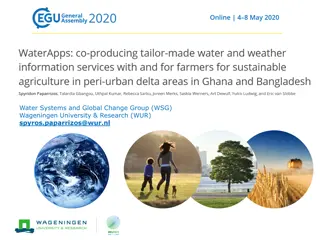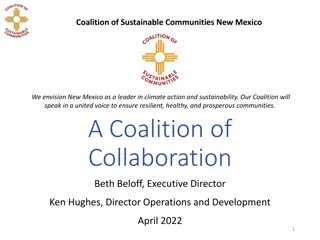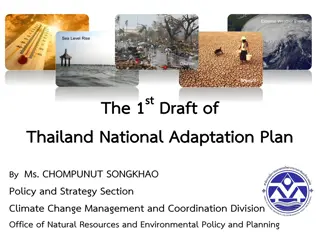Sustainable Shaftesbury Climate Action Meeting Agenda and Nature Action Plan Review
Agenda for the Sustainable Shaftesbury Climate Action Group meeting on February 14th, 2023, includes progress review, engaging the community, transforming nature, supporting sustainable food, reducing consumption and waste, energy efficiency, and changing transportation habits. The meeting will also discuss the Climate Emergency Heatmap, Youth Council feedback, and Neighbourhood Plan updates focusing on biodiversity and wildlife conservation in Shaftesbury. Recommendations include adopting policies to prioritize nature conservation in all town planning.
Download Presentation

Please find below an Image/Link to download the presentation.
The content on the website is provided AS IS for your information and personal use only. It may not be sold, licensed, or shared on other websites without obtaining consent from the author.If you encounter any issues during the download, it is possible that the publisher has removed the file from their server.
You are allowed to download the files provided on this website for personal or commercial use, subject to the condition that they are used lawfully. All files are the property of their respective owners.
The content on the website is provided AS IS for your information and personal use only. It may not be sold, licensed, or shared on other websites without obtaining consent from the author.
E N D
Presentation Transcript
Sustainable Shaftesbury Climate Action Group
Agenda 14thFebruary 2023 1. Progress review since January meeting a) Engaging and enabling our community b) Transforming our Nature include Gardens/Hedges/Soil under this heading Shaftesbury Action Plan for Nature Sustainable Shaftesbury Biodiversity Action Plan WWF-RSPB-National Trust 'People's Plan for Nature' - 'Seven Key Areas for Action' c) Supporting Sustainable Food (update from Jenny M and Sam) d) Reducing Consumption and Waste include water under this heading e) Reducing Energy Demand and Producing Smarter Energy (update from Jenny M) include creating healthy homes.com discuss next steps f) Changing the way we move around - Link to Changing the Way we move around action plan
Agenda 14thFebruary 2023 2. Climate Emergency Heatmap Commonplace - crowdsource ideas from the community about how to take climate action in your local area. Link to Climate Heatmap info 3. Youth Council ideas/ feedback - Sustainable Shaftesbury Plan _ BL to update 4. Neighbourhood Plan review and update key topics 5. Any other business
Shaftesbury Action Plan for Nature Shaftesbury is a place rich in history as well as natural history. Buildings, gardens, parks, hedgerows, carparks, roundabouts and road verges all offer nature a foothold. Connectivity is the key. Any work on the quality of our surroundings must bring benefits to nature as well as ourselves and offer example to people within and beyond our boundaries. All Town Council Policies and actions should incorporate Protecting existing nature (not only open space ) Improving quality of nature, importantly including connectivity Increasing nature - habitats and abundance of species Recommendations: A) for the Town Council to adopt a set of aims, principles and policies to apply to all management plans/neighbourhood plans etc to include: - priority given to the needs of nature in all aspects of all plans relating to the town, especially native and locally vulnerable species - much greater emphasis on the need for biodiversity in the Neighbourhood Plan and all other land use plans - with advice from Sustainable Shaftesbury and other groups/individuals - much stronger arguments for wildlife in all responses to planning applications especially for housing developments. Insist on statutory provision of swift and house martin nesting boxes - all open spaces should be protected by Fields in Trust - creation of wildlife corridors and permeable access for wildlife through boundaries - a comprehensive policy is made for the management of all grassy areas, including road verges, with the objective of increasing wildlife biodiversity, following a comprehensive survey of such areas - inclusion of wild areas, longer grass on the edges of play areas, wildflowers/longer grass in selected verges - introducing cut and collect mowing on verges etc, and less frequent and careful timing of mowing, to reduce the fertility and increase the ability of wild flowers to spread, and some areas of longer grass for wildlife - banning the use of glyphosate (and other poisonous chemicals) and insecticides such as slug pellets that kill hedgehogs etc on all Town Council owned land including allotments - providing ponds/areas of standing water where feasible and installing rainwater butts on suitable Town Council properties - making all new surfaces in town permeable and demanding developers etc do likewise - to resurface Park Walk to give the trees more access to rainwater and to lessen run off and erosion of The Slopes as well as for aesthetic reasons, and to offer example beyond tarmac
Shaftesbury Action Plan for Nature B) Communication: - Opportunities for this group to comment on the written briefs and management plans for each open space - Improvement of communication of these aims and policies by the Town Council to towns folk - Liaison with Dorset Council, Dorset CAN, Wiltshire Council and surrounding parishes re egs of good practice. - The creation of a Lets Go Wild leaflet for gardeners with an illustration by Gary Cook on the front and ideas to help nature in gardens on the back (see sketch below). C) Mapping: - For the Town Council to create an overview of the Parish and its hinterland, different land uses, to see how open spaces can be improved for nature by making links - green corridors - between them, where the provision of water, more trees etc would be beneficial... - By making a series of digital maps with guidance and assistance from Bernard Ede. Clear objectives for the mapping process need to be defined - what they are used for and by whom. D) Practical Projects: - Continuing support by the Town Council of the work of existing groups such as Shaftesbury Hedgehogs, Shaftesbury Swifts, Shaftesbury Tree Group, Shaftesbury Home Grown etc - Supporting new projects suggested by this sub-group and others such as: Water management in the parish: eg ponds in gardens, bathing water for creatures, springs, wells, SUDS, permeable paving, rain butts. Ideas for helping nature in gardens - bird boxes, hedgehog boxes etc.
Sustainable Shaftesbury Biodiversity Action Plan 1. Aims & Objectives Over-riding concept of 'health' of the Planet the integration of man-made & natural systems. Ecosystem structure & processes in equilibrium & relatively stable. Biodiversity & landscape ecology resilience based on species diversity. Avoid fragmentation of areas & areas too small, scattered & disconnected to support ecosystem functions & constituent species. Ensure a system of landscape connections between large habitats to create a network or matrix with patches. Human needs, perceptions & aspirations are part of the ecosystem. Contain & constrain development within reasonable bounds to avoid destroying the original resource; concept of 'carrying-capacity', a phrase borrowed from rangemanagement, meaning a number of people, or the intensity of activity, that a ground can support without losing it's ability to renew itself. Minimise disruption & severance from nature & natural systems & processes. Understand 'systems' as a structural set of components & functions which may be quite different but are relatively stable, where there are reciprocal relationships where change can precipitate or trigger sudden or prolonged unforeseen events. Balance or 'dynamic equilibrium' of underlying natural processes. Habitats & species as integral parts of the man-made environment. Man-made development or settlement as 'habitat .
Sustainable Shaftesbury Biodiversity Action Plan 2. Method Understand the land, natural processes & human interaction. Ecological inventory mapping of existing situation - landscape/ecological features such as; geology, topography, surface water drainage, soils, vegetation, land-use & management practices etc. Define assets, problems, constraints & opportunities of a baseline landscape ecology for enhancement with minimum disruption to habitats. Define activities that protect or are destabilising & technologies that are employed, resources conserved or wasted & behaviour that is endangered. Define links between living systems which make use of output from one system as input to another. Reject destructive, consumptive destabilising technologies in favour of regenerative sustainable technologies. Nurture, reinforce & sustain social & cultural values. Promote & make sustainable technologies more visible & closer to home. Create tangible landscape examples. Identify surface water management practices & recognise the significance of appropriation of water & it's use/misuse. Identify impermeable & permeable hard surfaces as major determinants in water management. Maintain vegetation which has several functions including vertical & horizontal structured habitats. Define open-space system hierarchy from built labyrinth-like spaces to more open areas. Create multi-functional spaces, Green Infrastructure & Sustainable Urban Drainage System network to form connected framework for natural processes supporting species diversity integrated with development/settled areas. Make 'creative leap' from inventory & analysis to vision/concept for the Town. Revisit Neighbourhood Plan which included thorough comprehensive open-space audit but stopped short of prescriptive/proposals stage
Sustainable Shaftesbury Biodiversity Action Plan 3. Design Wildlife Habitats Valleys, wooded areas, scrub thickets, hedges, grassland, roadsides provide penetration into the town & constitute a 'food-web . Wildlife linked to each other & vegetation form a sum of relationships between eater & the eaten. Urbanisation & development interrupts this web. Size, shape & location of habitat (ecosystem) are significant together with their physical connection to larger areas within or beyond the town Habitat size is often a limiting factor patches & strips of suitable habitat are often isolated by a matrix of buildings, roads, paving & lawns. Objective of self-perpetuating & self-renewing habitats with degrees of responsive management interventions appropriate to specific locations rather than blanket solutions. Objective to create spectrum of habitats within the town that will support breeding populations & permit migration of species. Viable habitats provide food & cover. Important to provide patches, strips, edges & interiors, especially with undulating (plan) edges & interfaces. Size & continuity alone are not sufficient to guarantee diversity & abundant wildlife; plant species, age, condition, complexity of cover, arrangements & distribution also major determinants Diverse topography, aspect (orientation in relation to solar path), shelter/relative exposure to prevailing & localised wind, microclimate, parent ground material, soil type, structure & conditions & vegetation contribute to diversity. Appropriate plants, their layout & maintenance regimes for food provision, to be arranged to provide cover for nesting, feeding & protection from predators Landscape maintenance regimes coordinated with wildlife needs such as mating, nesting etc. Regimes to be adjusted responsively. Design or sustaining wildlife not considerations in isolation but compatible with other functions such as stormwater management, micro-climatic modification, air quality control, erosion control etc
Sustainable Shaftesbury Biodiversity Action Plan 4. Geographic Information System (GIS) GIS is considered an essential tool in land management & diversity creation. GIS is a computer-based spatial analysis system which defines areas or features to which are assigned characteristics or attributes. Maps & plans are scalable; i.e. outputted at various scales to show large-scale relationships or to provide bases for more detailed survey & analysis. In the UK, GIS systems can be linked to & based upon Ordnance Survey spatial mapping. Free GIS software is available such as QGIS. STC use PEAR system of base-mapping - investigate compatibility with GIS several Agencies have existing digital mapping systems which can be incorporated into GIS. Such as OS, DEFRA's MAGIC system, British Geological Survey, Soil Survey, Natural England. Their data can be brought together as one of our tools. LATEST NEWS Natural England (NE) are issuing their 'Green Infrastructure Framework Mapping Tool' Principles & Standards Report on 31 January 2023 aimed at Local Authorities, stakeholders & interest groups. BE 30thJanuary 2023
Changing the Way we move around The strategic aspirations of the Town Council will need to reflect the Government Policy on: - Active Transport Walking and Cycling short journeys in the urban environment - The transition to Electric Vehicles to replace the petrol and diesel vehicles that will be banned from sale after 2030 just 7 years from now Active Transport Surveys indicate that safety is one of the key inhibitors to residents adopting walking and cycling when moving around in the urban environment. Town Council Action A review of safety of the High Street and surrounding access roads for pedestrian users is a priority. There are serious problems with the width of pavements in this area, particularly for parents with pushchairs and with additional children walking alongside. There are the same problems for people in wheelchairs and mobility scooters. It needs to be noted that the regulations for Class 2 mobility scooters state that they should only be ridden on the pavement NOT on the road. Shaftesbury town centre makes it almost impossible for a Class 2 mobility scooter-user to comply with these regulations. There are sections of the footpath network where pavements become very narrow and have curbs that do not allow the safe use of a mobility scooter, and they also leave parents with young children at risk from road traffic. How can the Safety for Cyclists be addressed? There is an opportunity to improve the safe access to the cycle track outside LIDL by linking it to Barton Hill at the North end of the Track. This action would also link the track to the Pelican crossing to the East side of Town at the Fire Station. The Fire Station side of the Pelican crossing could also be improved for cyclists using the crossing to access the East side via Wincombe Lane. Access to the town at the South end of Christy s Lane can be achieved with improvements to the Pelican crossing at Mampitts Lane so that cyclists can cross into Coppice Street and up into the High Street. Cycling from new Residential Developments on the edge of Town Urgent consideration needs to be given to the access to town for cyclists from Littledown, Saxon Grange and other sites in the planning stage.
Changing the Way we move around There will always be competition for electric charging points! Dorset Council has adopted an electric vehicle strategy with objectives for the period 2021 2023. These objectives take into account the likely ownership of electric vehicles in the period up to 2030 when new petrol/diesel cars will no longer be sold. It is estimated that ownership of electric vehicles will be between 21% to 30% of the car-owing population by 2030. This will be approximately 91,000 electric vehicles in the Dorset area. Dorset Council estimates that a third of households have no off-street parking to accommodate their own vehicle charging. Electric Vehicle Charging Hubs Dorset Council proposes that urban areas will need to accommodate charging hubs in suitable locations where multiple electric vehicles will be able to access electric chargers - note, NOT on pavements adjacent to roads where they will obstruct pedestrians. Dorset Council sees Town Councils as key stake-holders in the transition to the use of use of electric vehicles. Dorset Council s strategy sees Town Councils supporting the identification of suitable locations for charging hubs with a feasibility study. There will also need to be liaison with electrical supply companies to verify that there is adequate capacity on the local grid for electrical vehicle charging. Public Transport Consideration also needs to be given to the possible provision for electric bus charging (Bell Street bus terminus?). JN/CS 8th February 2023
https://retrofit.brutontown.com/technical/ 2019-08/A4_ClimateActionPlan.pdf Friends of the Earth Climate Action Plan
March Planet Shaftesbury meeting - A forum for discussing the emerging Sustainable Shaftesbury Plan
Dorset Climate Action Network (DCAN) Dorset Council's new 'Natural Environment, Climate and Ecology Strategy'























